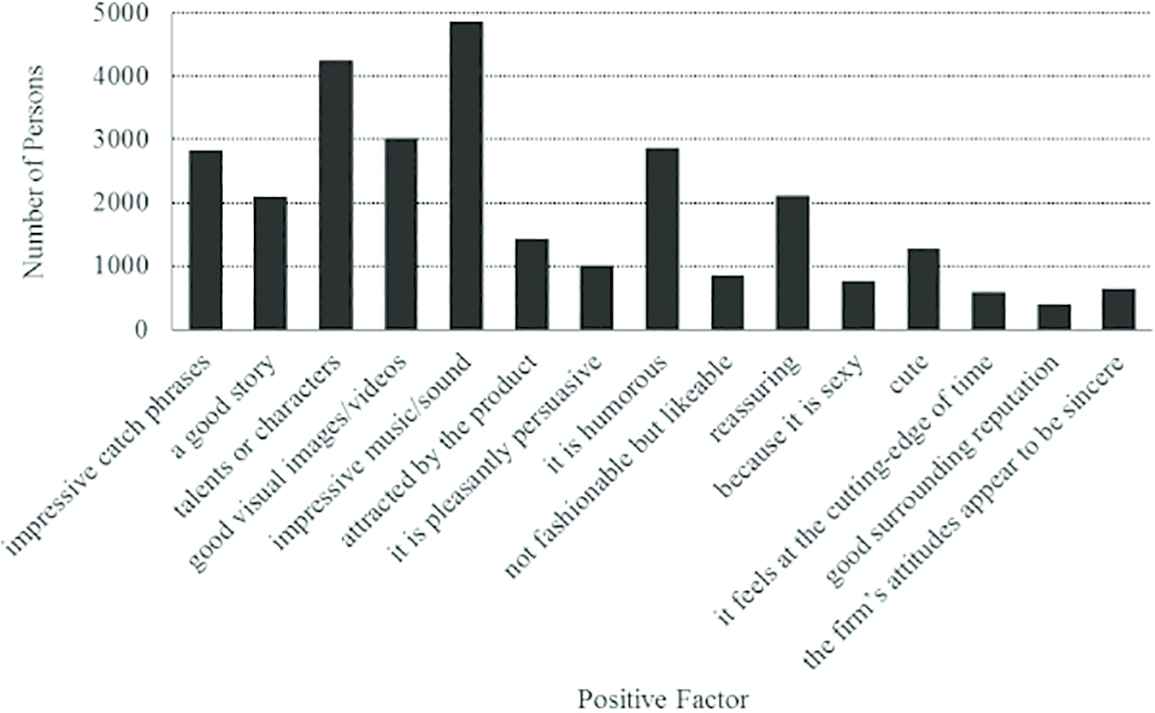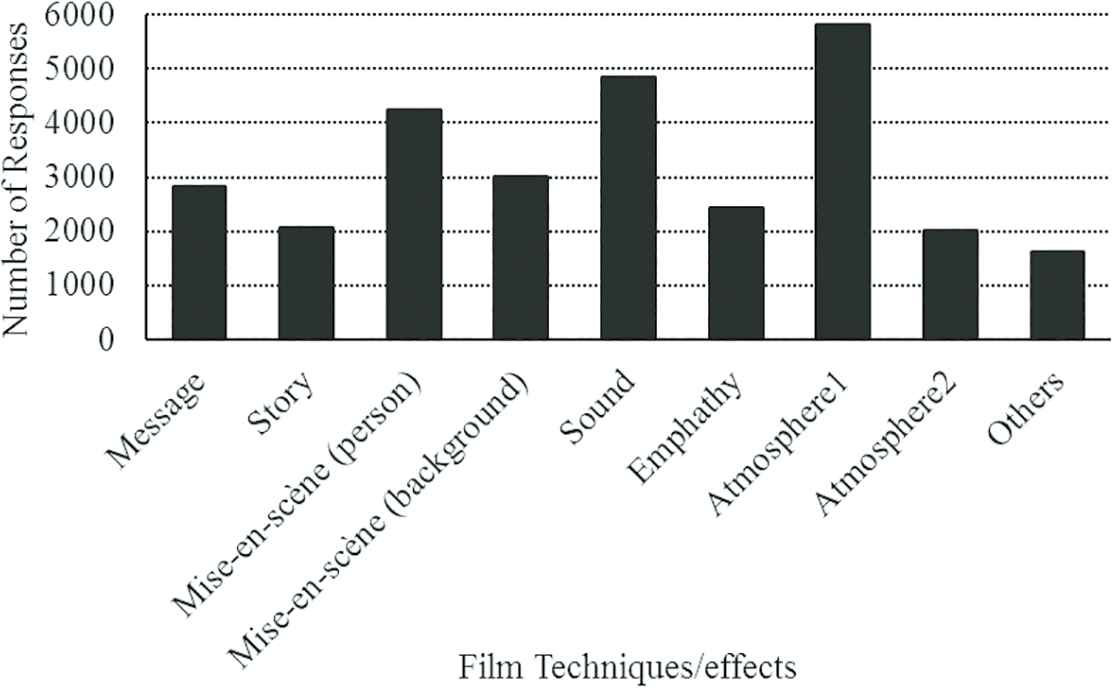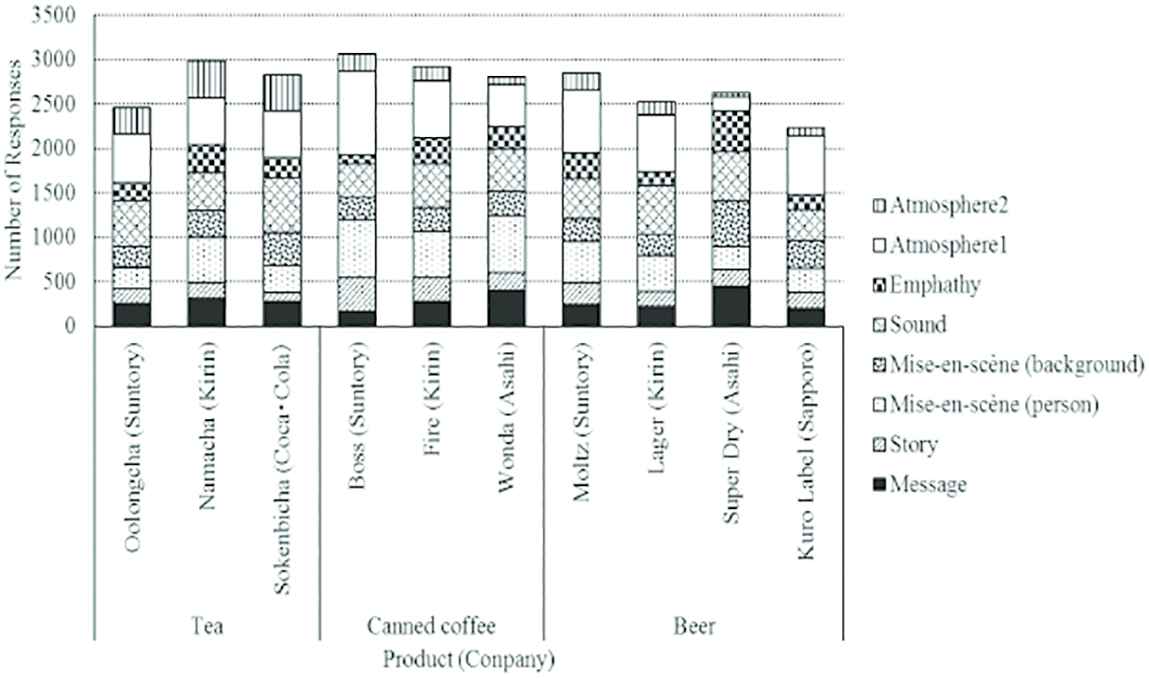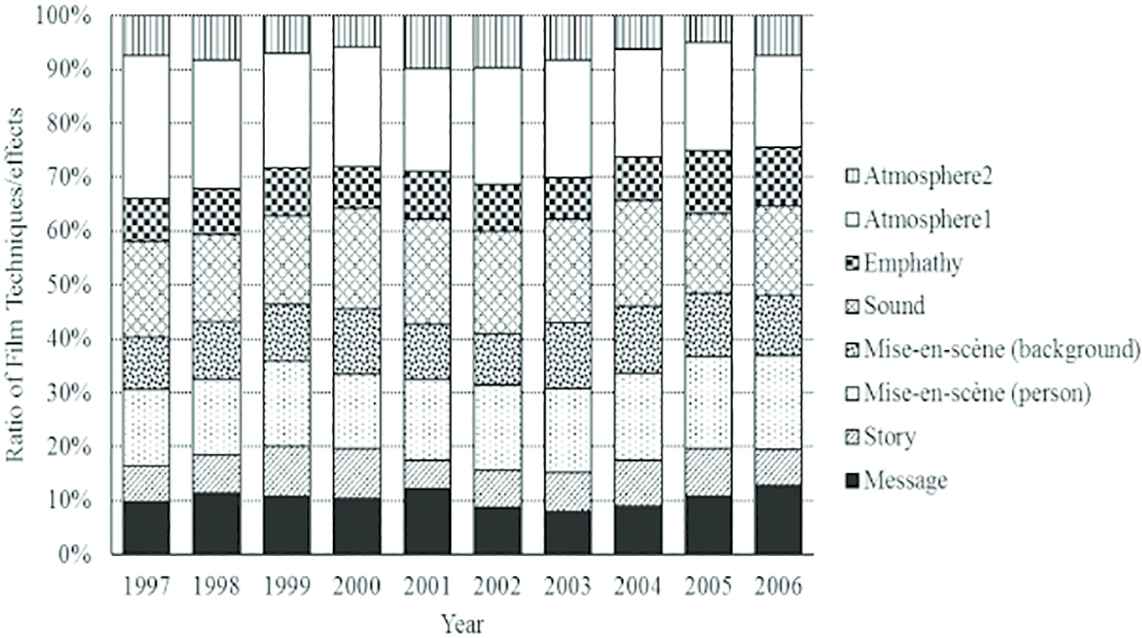An Analysis on Commercial Film Techniques and Effects Using Positive Factors of Evaluation Database System
- DOI
- 10.2991/jrnal.k.190531.001How to use a DOI?
- Keywords
- Commercial film; film technique; effect; positive factor; beverage
- Abstract
This study aims to systematically shed light on what kind of effects are brought about by the film techniques in individual commercial messages. Based on audiovisual experiments, with positive factors as the evaluation index, we considered what could be analyzed from film techniques and their effects. For this study, we conducted audiovisual experiments of communication effects (positive factors, interest, and the willingness to buy) by using 100 commercials for beverages (tea, canned coffee and beer), and analyzed the relationships between film technique and product and category characteristics, historical transitions, interest, and the willingness to buy. Subsequently, we examined the results of the audiovisual experiments. According to the tabulation results, the tea Sokenbicha (Coca-Cola) and Namacha (Kirin) tended to focus on “atmosphere 2 (sexy or cute)”; canned coffee Boss (Suntory) tended to focus on the “story,” “mise-en-scène (person),” and “atmosphere 1 (humor)”; canned coffee Wonda (Asahi) tended to focus on “message” and “mise-en-scène (person)”; and Super Dry beer (Asahi) tended to focus on “message,” “mise-en-scène (background),” and “empathy.” These kinds of film techniques and effects structure a product’s brand image or “identity.” According to our quantitative formulation, “mise-en-scène (person),” “mise-en-scène (background),” “story,” and “sound” are important for increasing the level of interest. “Empathy,” “mise-en-scène (background),” and “message” are important for increasing the level of willingness to buy.
- Copyright
- © 2019 The Authors. Published by Atlantis Press SARL.
- Open Access
- This is an open access article distributed under the CC BY-NC 4.0 license (http://creativecommons.org/licenses/by-nc/4.0/).
1. INTRODUCTION
Even though film techniques and effects of television commercial message (CM) have been studied by researchers such as Stewart and Furse [1] and Kawamura [2–6], CMs are complex information media, and hence it takes a significant amount of time and effort to evaluate a CM comprehensively. Therefore, attempts to systematically study film techniques and their effects have been largely unsuccessful. Meanwhile, in the advertising business, the CM Soken Consulting built a system for evaluating CM expressions comprehensively, using CM likability studies within the framework of positive factors. The positive factors of the CM Soken Consulting have by no means one to one correspondence with film techniques, but a number of them involve film techniques. Probably, the institute also has a research approach that examines the effects and transitions in film techniques based on a comprehensive evaluation database by using positive factors as the evaluation index. However, the CM likability surveys of the CM Soken Consulting depend on the ad placement frequency and social environment (such as trends and current affairs), and hence they do not evaluate the film technique of an individual CM.
This study aims to systematically shed light on what kind of effects are brought about by the film techniques in individual CMs. Based on audiovisual experiments, with positive factors as the evaluation index, we considered what could be analyzed from film techniques and their effects. For this study, we conducted audiovisual experiments of communication effects (positive factors, interest, and the willingness to buy) by using 100 commercials for beverages (tea, canned coffee and beer), and analyzed the relationships between film technique and product and category characteristics, historical transitions, interest, and the willingness to buy. Subsequently, we examined the results of the audiovisual experiments.
2. POSITIVE FACTORS AND FILM TECHNIQUES
The CM Soken Consulting conducts monthly CM likability surveys and provides a database service for evaluating CM expressions. The CM likability surveys study likability by gender and age groups, by using 15 types of positive factors [7]. Our study evaluated impressions (feelings) after viewing the CMs, with items relating positive factors to effects (impressions and feelings from the commercial as a whole) and items relating to film techniques (such as story, mise-en-scène, and sound). The positive factors were set empirically, and hence a challenge was that the questions about items related to film techniques did not cover film techniques precisely or exhaustively. However, due to the existence of questions relating to major film techniques, we believe that the questionnaire provides a valuable database for the analysis of film techniques. According to film theory [8–12], films are composed of stories (how the intended content is constructed by means of cinematic expression), mise-en-scène (how shots [information elements and compositions on the screen] are structured), editing (how shots are connected), and sound (what type of sound is added to shots and the edited video products). In this study, we performed our analysis by taking into account these considerations and mapping the positive factors to the film techniques/effects shown in Table 1.
| Film techniques/effects (nine categories) | Positive factors (15 indicators) | |
|---|---|---|
| Film technique | Message | “Impressive catch phrases” |
| Story | “A good story” | |
| Mise-en-scène (person) | “Talents or characters” | |
| Mise-en-scène (background) | “Good visual images/videos” | |
| Sound | “Impressive music/sound” | |
| Effect | Emphathy | “Attracted by the product” |
| “It is pleasantly persuasive” | ||
| Atmosphere 1 | “It is humorous” | |
| “Not fashionable but likeable” | ||
| “Reassuring” | ||
| Atmosphere 2 | “Because it is sexy” | |
| “Cute” | ||
| Other | “It feels at the cutting-edge of time” | |
| “Good surrounding reputation” | ||
| “The firm’s attitudes appear to be sincere” | ||
The film techniques/effects and positive factors
3. ANALYSIS METHOD
3.1. Analysis Targets
Beverages are low involvement products, and compared to CMs for other products, CMs for beverages make full use of film techniques. Therefore, we chose ten major products Table 2 within the beverage category (tea, canned coffee and beer) as targets for analysis. To investigate from a diachronic perspective, we surveyed a total of 100 CMs created during a span of 10 years from 1997 to 2006 (number of samples: 10 CM’ for each product).
| Category | Product (Company) |
|---|---|
| Tea | Oolongcha (Suntory), Namacha (Kirin), Sokenbicha (Coca-Cola) |
| Canned coffee | Boss (Suntory), Fire (Kirin), Wonda (Asahi) |
| Beer | Moltz (Suntory), Lager (Kirin), Super Dry (Asahi), Kuro Label (Sapporo) |
The targets for analysis
3.2. Subjects
The subjects were students between the ages of 20 and 23 years. The number of samples was 100 human subjects for each of these commercials.
3.3. Indicators and Evaluation
As positive factor indicators for the audiovisual experiments, we used the CM Soken Consulting’s indicators (15 indicators) Table 1. We used a two-point scale for evaluating the positive factors (“left an impression” and “did not leave an impression”). For tabulation and analysis, we also analyzed indicators classified from the standpoints of film techniques and effects (film techniques/effects: nine categories). To measure the level of interest, we used a five-point scale (1: Not interested, 2: Not particularly interested, 3: Fairly interested, 4: Pretty interested, 5: Extremely interested). To measure the level of willingness to buy, we used a five-point scale (1: Definitely would not buy, 2: Probably would not buy, 3: Might buy, 4: Probably would buy, 5: Definitely would buy).
3.4. Audiovisual Experimental Method
We showed the CM to 100 subjects and got them to evaluate their level of interest (five-point scale), willingness to buy (five-point scale), and positive factors (two-point scale, 15 types). For tea and canned coffee, we aired six CMs (CMs for three products, created in two different years) to the same subjects and gathered evaluations. For beer, we aired and evaluated eight commercials (commercials for four products, created in two different years). We elicited responses from subjects concerning their attributes of gender and consumption frequency (daily, two to three times per week, once a week, once a month, and almost never consumed).
3.5. Tabulation and Analysis Method
Based on the collected evaluation data, we tabulated film techniques and effect categories and analyzed characteristics by product, characteristics by category, and historical transitions. We also performed a regression analysis of the relationships between the interest and willingness to buy and film techniques and effect categories.
4. RESULTS AND ANALYSIS
4.1. Summary
A total of 10,000 samples were tabulated, comprising 50.5% and 49.5% of males and females, respectively. The totals for the interest level and the willingness to buy are shown in Figure 1. The proportion of subjects interested (3–5 scales) and those who expressed a willingness to buy (3–5 scales) accounted for 70.2% and 58.7%, respectively. The positive factors’ totals are shown in Figure 2. Overall, the highest-rated factor (left an impression) by positive factors was “impressive music/sound.” This was followed by “talents or characters,” “good visual images/videos,” “it is humorous,” and “impressive catch phrases.” Based on the categories shown in Table 1, the results of tabulation of film techniques/effects are shown in Figure 3. For film techniques/effects, overall, the “atmosphere 1” received a very high evaluation. In these categories, the next highest were “sound,” “mise-en-scène (person),” “mise-en-scène (background),” and “message.”

The totals of interest level and the willingness to buy.

The positive factors’ totals.

The results of tabulation of film techniques/effects.
4.2. Relationship between the Interest Level and Willingness to Buy and the Positive Factors
We performed regression analysis, with the interest level and the willingness to buy as explained variables (five-point scale) and positive factors as explanatory variables. Figure 4 shows the level of influence (the regression formula coefficient) of interest and willingness to buy on the positive factors. “Talents or characters” had the highest impact on interest, followed in order by “attracted by the product,” “a good story,” and “good visual images/videos.” “Attracted by the product” had the highest impact on the willingness to buy, followed in order by “it is pleasantly persuasive,” “because it is sexy,” “good visual images/videos,” and “impressive catch phrases.” Overall, the “impressive music/sound” was most highly evaluated, but it did not have a very significant impact on the interest or willingness to buy.

The regression formula coefficient of interest and willingness to buy on the positive factors.
4.3. Characteristics of Film Techniques/effects Categories by Product
Figure 5 shows the totals by the product of film techniques/effects. Sokenbicha (Coca-Cola) and Namacha (Kirin) had the highest evaluation among the teas for “atmosphere 2,” and the canned coffee Boss (Suntory) had the highest evaluations for “story,” “mise-en-scène (person),” and “atmosphere 1,” and canned coffee Wonda (Asahi) had the highest evaluations for “message” and “mise-en-scène (person).” Super Dry beer (Asahi) had the highest evaluations for “message,” “mise-en-scène (background),” and “empathy.”

The totals by the product of film techniques/effects.
4.4. Characteristics by Film Techniques/effects by Category
Figure 6 shows the totals by category of film techniques/effects. Tea had the characteristic of being highly evaluated for “atmosphere 2,” and canned coffee had the characteristic of being highly evaluated for “story,” “mise-en-scène (person),” and “atmosphere 1.”

The totals by category of film techniques/effects.
4.5. The Historical Transition of Film Techniques/effects
Figure 7 shows the historical transition of film techniques/effects. Compared with 1997, in 2006, there was an increasing trend in the ratio of “mise-en-scène (person)” and “empathy” and a decreasing trend in the ratio of “atmosphere 1.’

The historical transition of film techniques/effects.
4.6. Relationships between the Interest and the Willingness to Buy and Film Techniques/effects
Figure 8 shows the relationships (cross tabulation) between interest and willingness to buy and film techniques/effects. Depending on the level of interest and willingness to buy, the proportion of which film technique or effect category being influenced underwent a change. When the levels of interest and willingness to buy become higher, the proportions of “atmosphere 1” and “sound” become smaller. When the levels of interest and willingness to buy become higher, the proportions of “mise-en-scène (background)” and “empathy” tend to become larger.

The cross tabulation between interest and willingness to buy and film techniques/effects.
We performed a regression analysis, with the level of interest and willingness to buy as explained variables and film techniques/effects as explanatory variables.
The regression formula was:
Figure 9 shows the level of influence (regression formula coefficient) of film techniques/effects on the interest and willingness to buy. “Mise-en-scène (person)” had the greatest impact on interest, followed by “mise-en-scène (background),” “story,” “empathy,” and “sound.” “Empathy” had the greatest impact on willingness to buy, followed by “mise-en-scène (background)” and “message.” Mise-en-scène (person and background) and story fulfill large roles in gaining interest. It is important to obtain empathy in order to drive the willingness to buy, and the message that forms the context for the mise-en-scène fulfills an important role.

The regression formula coefficient of film techniques/effects on the interest and willingness to buy.
5. OUTCOMES AND FUTURE CHALLENGES
5.1. Quantification of Brand Images
This study conducted audiovisual experiments of communication effects (positive factors, interest, and the willingness to buy) by using 100 CMs for beverages (tea, canned coffee and beer) and analyzed the relationships between film technique and product and category characteristics, historical transitions, interest, and the willingness to buy, based on the evaluation of positive factors. When compared with a large number of CMs created in a 10-year period (said to exceed 30,000), 100 CMs represent a small number, but they have significance in that their effects for advertising the same brands over the period of 10 years were evaluated. According to the tabulation results, the tea Sokenbicha (Coca-Cola) and Namacha (Kirin) tended to focus on “atmosphere 2 (sexy or cute)”; canned coffee Boss (Suntory) tended to focus on the “story,” “mise-en-scène (person),” and “atmosphere 1 (humor)”; canned coffee Wonda (Asahi) tended to focus on “message” and “mise-en-scène (person)”; and Super Dry beer (Asahi) tended to focus on “message,” “mise-en-scène (background),” and “empathy.” These kinds of film techniques and effects structure a product’s brand image or “identity.” Our study is significant because it was able to elucidate this in a quantitative way. It is possible to utilize these techniques and effects as quantitative indicators for maintaining and innovating brand images. This study does not specifically address this point, but it is possible to use this methodology to analyze the historical transitions of brand images for each brand.
5.2. Quantitative Formulation of Relationships between Interest and the Willingness to Buy and Film Techniques/effects
It is not easy to quantitatively evaluate the effects of film techniques, but this study attempted a quantitative formulation of the relationship between interest and the willingness to buy and film techniques/effects. Our study is significant because it could shed quantitative light on the kinds of film techniques on which efforts must be focused in order to trigger interest and the willingness to buy. According to our quantitative formulation, “mise-en-scène (person),” “mise-en-scène (background),” “story,” and “sound” are important for increasing the level of interest. “Empathy,” “mise-en-scène (background),” and “message” are important for increasing the level of willingness to buy. A creator of advertising would probably see these results as obvious, but the significance of the results is that they clearly demonstrate the impact in a quantitative way.
5.3. Automation of Communication
In other studies, through a variety of audiovisual experiments, in addition to the formulation demonstrated in Section 5.2., Kawamura [13,14] has attempted to extract the film techniques that draw interest and those that drive the willingness to buy. If these techniques (rules) can be made specific and used with information systems technologies, then they would significantly contribute toward upgrading marketing automation.
5.4. Analysis of Film Techniques and their Effects Using a CM Evaluation Database Using Positive Factors as an Evaluation Index
At present, the CM Soken Consulting do not cover any survey items regarding interest or willingness to buy in its CM likability surveys, but it is possible to calculate the interest and willingness to buy based on the formulated functions. The formulation clearly depicts relationships between levels of interest and “mise-en-scène (person),” “mise-en-scène (background),” “story,” “empathy,” and “sound,” and there is a strong relationship between the level of willingness to buy and “empathy.” Simply put, we believe that “film technique” (= “a good story” + “talents or characters” + “good visual images/videos” + “impressive music/sound”) is an indicator for evaluating interest, and “empathy” (= “attracted by the product” + “it is pleasantly persuasive”) is an indicator for evaluating the willingness to buy. If we use these methods of analysis as the basis for analyzing data in a comprehensive system for evaluating CM expressions, then we would be able to analyze the film techniques comprehensively and quantitatively and analyze their effects for diverse product categories and from a variety of time periods.
5.5. Future Challenges
This study targeted beverages for analysis, and hence it will also be necessary to attempt to analyze other product categories. Additionally, our subjects comprised the younger generation (aged 20–23 years), and hence it will also be necessary to attempt to analyze other age groups. Based on these analysis, in the medium- and long-term, we would like to conduct a comprehensive analysis of film techniques and their effects using an advertising evaluation database, and formulate a system out of these.
CONFLICTS OF INTEREST
There is no conflicts of interest.
ACKNOWLEDGMENT
This work was supported by JSPS KAKENHI Grant Number 22500102.
Author Introduction
Mr. Yoji Kawamura
 He received his MBA from Graduate School of Business Science, University of Tsukuba, Japan in 1993. He is a Professor in the Faculty of Business Administration, Kindai University, Japan. His majoring is modeling the various social phenomena based on the modeling of consumer and the system building for simulation.
He received his MBA from Graduate School of Business Science, University of Tsukuba, Japan in 1993. He is a Professor in the Faculty of Business Administration, Kindai University, Japan. His majoring is modeling the various social phenomena based on the modeling of consumer and the system building for simulation.
REFERENCES
Cite this article
TY - JOUR AU - Yoji Kawamura PY - 2019 DA - 2019/06/25 TI - An Analysis on Commercial Film Techniques and Effects Using Positive Factors of Evaluation Database System JO - Journal of Robotics, Networking and Artificial Life SP - 1 EP - 6 VL - 6 IS - 1 SN - 2352-6386 UR - https://doi.org/10.2991/jrnal.k.190531.001 DO - 10.2991/jrnal.k.190531.001 ID - Kawamura2019 ER -
